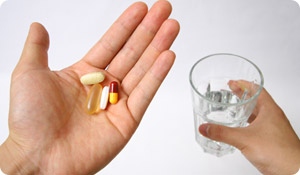
Whether you reach for prescription pills on a daily basis or take an over-the-counter remedy for a persistent cough or occasional headache, there are risks associated with all medications especially when they are combined with other medications.
According to the National Safety Council (NSC), increases in accidental overdoses of over-the-counter, prescription, and illegal drugs are one of the fastest-rising causes of accidental death in the United States.
The NSC reported an estimated 25,000 people die of unintentional poisonings from these substances each year. The biggest rise in accidental poisonings is among men and women between the ages of 20 to 64 and is mainly due to the overuse of prescription pain medicines such as oxycodone, methadone, hydrocodone, fentanyl, and buprenorphine.
Pain relief medicines—also known as "analgesics" and "painkillers"—are regulated by the Food and Drug Administration (FDA). There are two varieties of over the counter (OTC) pain relief:
- Acetaminophen which is found in more than 600 OTC (and prescription) pain relievers, cough suppressants, and cold medications. Acetaminophen does not reduce inflammation and is easier on the stomach than other pain medications.
- Non-steroidal anti-inflammatory drugs (NSAID) like aspirin, naproxen, and ibuprofen, which are also used to relieve fever and pain and commonly found in allergy and cold medications. NSAID reduce swelling and work by inhibiting an enzyme.
In terms of prescription pain medications, there are opioid and non-opioid products. Opioid drugs such as morphine, oxycodon and hydrocodon are often combined with acetaminophen. They are derived from opium and powerfully change the way a person experiences pain.
"There is a huge epidemic of opioid abuse in this country," says G. Caleb Alexander, MD assistant professor of medicine at the University of Chicago Medical Center citing high profile incidents involving professional athletes, celebrities and the recent death of comedian Greg Giraldo. "Efforts are needed to decrease the use of these therapies among patients who stand little or nothing to gain from them as well as to stop the diversion of these medicines to settings where they are used illicitly or without a prescribers' close supervision."
Many consider acetaminophen an extremely safe medication and when used properly, it is. However, Alexander, who is also a pharmacoepidemiologist, reports one common scenario.
"Patients may unintentionally take more acetaminophen than is recommended, or may unknowingly overdose by unintentionally combining it with other treatments, such as prescription pain medicines that also contain the same drug."
Taking more than the maximum recommended dose (for adults, just 4 grams per day) can cause serious and possibly fatal liver disease.
Symptoms of too much acetaminophen include:
- abdominal pain,
- loss of appetite,
- coma, convulsions,
- diarrhea,
- jaundice,
- nausea and vomiting,
- sweating
and may not occur until 12 or more hours after the acetaminophen was swallowed. Chances of recovery from an overdose are greatly improved if treatment is administered within the first 18 hours of ingestion.
Tips to Keep You Safe
Here, medication safety tips from the National Safety Council and Dana Simpler, MD, an internist in private practice in Baltimore, MD:
- Always follow a medication's recommended dosage.
- Clean out your medicine cabinet. Dispose of any unused or expired prescriptions by mixing with coffee grounds or kitty litter, sealing and putting in the trash. Do not flush down the toilet as the medication can leech into the water supply.
- Never take someone else's medications.
- Keep medications safely secured and out of the reach of children.
Especially for older adults:
- If you have multiple doctors, make your own list of medications and show it to each doctor you visit.
- "Check with your internist/primary care doctor when another doctor adds a medicine," says Dr. Simpler. "Especially an orthopedist who might prescribe a strong NSAID for pain not realizing how it will increase blood pressure, cause ulcers or kidney trouble in susceptible patients."
- If you are taking two or more prescriptions or over-the-counter medications, ask your pharmacist about unintended drug interactions.
- Medicine labels can be printed in larger type if reading them is a problem for you.
- Pharmacists can also provide alternative medicine caps if the child-restraint variety proves difficult to use.
- Always use dosage containers to avoid dosage errors. Dosage containers that divide medicines by the day of the week and/or time of day can be very helpful. Never leave medication dosage to memory.
- Don't assume that OTC meds/vitamins/supplements have no side effects.
"When I have a patient with peculiar symptoms I sometimes find they are having a reaction to an OTC supplement or supplements that they are taking 'to be healthy'!" says Dr. Simpler adding that headaches, stomach distress, constipation, and fatigue are unusual symptoms.
"Stop taking supplements if you are experiencing any of those symptoms and see if the symptom goes away. Just because you read somewhere that a certain supplement is 'good' for you doesn't mean it's right for everyone." Simpler also says that since supplements are not tested or regulated, consumers need to be good detectives. "It just may be the health supplements that are making you ill."
Sources:
Univ. of Cincinnati, Case Western Reserve University, Ohio State Univ. Net Wellness
http://netwellness.uc.edu/healthtopics/pharmacy/w6.cfm
National Safety Council
http://www.nsc.org/Pages/NationalPoisonPreventionWeek.aspx
Interview with G. Caleb Alexander, MD, board certified internal medicine doctor; assistant professor of medicine, University of Chicago Medical Center
http://www.uchospitals.edu/physicians/physician.html?id=80208
Interview with Dana Simpler, MD, internist in private practice in Baltimore, MD
FDA
http://www.fda.gov/forconsumers/consumerupdates/ucm095673.htm





